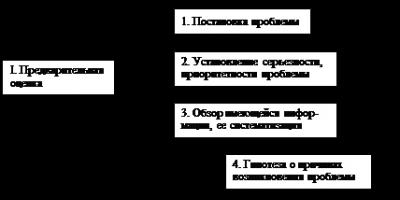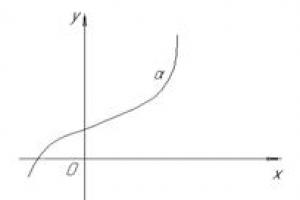Equation of a line as a locus of points. Different types of straight line equations. Study of the general equation of the line. Constructing a line using its equation
Line equation called an equation with variables x And y, which is satisfied by the coordinates of any point on this line and only by them.
Variables included in the line equation x And y are called current coordinates, and literal constants are called parameters.
To create an equation of a line as a locus of points that have the same property, you need:
1) take an arbitrary (current) point M(x, y) lines;
2) write down the equality of the general property of all points M lines;
3) express the segments (and angles) included in this equality through the current coordinates of the point M(x, y) and through the data in the task.
In rectangular coordinates, the equation of a straight line on a plane is specified in one of the following forms:
1. Equation of a straight line with a slope
y = kx + b, (1)
Where k- the angular coefficient of the straight line, i.e. the tangent of the angle that the straight line forms with the positive direction of the axis Ox, and this angle is measured from the axis Ox to a straight line counterclockwise, b- the size of the segment cut off by a straight line on the ordinate axis. At b= 0 equation (1) has the form y = kx and the corresponding straight line passes through the origin.
Equation (1) can be used to define any straight line on the plane that is not perpendicular to the axis Ox.
The equation of a straight line with a slope is resolved relative to the current coordinate y.
2. General equation of a line
Ax + By + C = 0. (2)
Special cases of the general equation of a straight line.
Let us consider a relation of the form F(x, y)=0, connecting variables x And at. We will call equality (1) equation with two variables x, y, if this equality is not true for all pairs of numbers X And at. Examples of equations: 2x + 3y = 0, x 2 + y 2 – 25 = 0,
sin x + sin y – 1 = 0.
If (1) is true for all pairs of numbers x and y, then it is called identity. Examples of identities: (x + y) 2 - x 2 - 2xy - y 2 = 0, (x + y)(x - y) - x 2 + y 2 = 0.
We will call equation (1) equation of a set of points (x; y), if this equation is satisfied by the coordinates X And at any point of the set and are not satisfied by the coordinates of any point that does not belong to this set.
An important concept in analytical geometry is the concept of the equation of a line. Let a rectangular coordinate system and a certain line be given on the plane α.



Definition. Equation (1) is called the line equation α
(in the created coordinate system), if this equation is satisfied by the coordinates X And at any point lying on the line α
, and do not satisfy the coordinates of any point not lying on this line.
If (1) is the equation of the line α, then we will say that equation (1) defines (sets) line α.
Line α can be determined not only by an equation of the form (1), but also by an equation of the form
F (P, φ) = 0 containing polar coordinates.
- equation of a straight line with an angular coefficient;
Let some straight line, not perpendicular, to the axis be given OH. Let's call inclination angle given straight line to the axis OH corner α , to which the axis needs to be rotated OH so that the positive direction coincides with one of the directions of the straight line. Tangent of the angle of inclination of the straight line to the axis OH called slope this line and is denoted by the letter TO.
|
|||
|
|||
Let us derive the equation of this line if we know its TO and the value in the segment OB, which it cuts off on the axis OU.

|
|
Equation (2) is called equation of a straight line with an angular coefficient. If K=0, then the straight line is parallel to the axis OH and its equation is y = b.
- equation of a line passing through two points;
|
|
If y 1 = y 2, then the equation of the desired line has the form y = y 1. In this case, the straight line is parallel to the axis OH. If x 1 = x 2, then the straight line passing through the points M 1 And M 2, parallel to the axis OU, its equation has the form x = x 1.
- equation of a straight line passing through a given point with a given slope;
|
|
and, conversely, equation (5) for arbitrary coefficients A, B, C (A And B ≠ 0 simultaneously) defines a certain straight line in a rectangular coordinate system Ooh.
Proof.
First, let's prove the first statement. If the line is not perpendicular Oh, then it is determined by the equation of the first degree: y = kx + b, i.e. equation of the form (5), where
A = k, B = -1 And C = b. If the line is perpendicular Oh, then all its points have the same abscissa, equal to the value α segment cut off by a straight line on the axis Oh.

The equation of this line has the form x = α, those. is also a first degree equation of the form (5), where A = 1, B = 0, C = - α. This proves the first statement.
Let us prove the converse statement. Let equation (5) be given, and at least one of the coefficients A And B ≠ 0.
If B ≠ 0, then (5) can be written in the form . Flat ![]() , we get the equation y = kx + b, i.e. an equation of the form (2) that defines a straight line.
, we get the equation y = kx + b, i.e. an equation of the form (2) that defines a straight line.
If B = 0, That A ≠ 0 and (5) takes the form . Denoting by α, we get
x = α, i.e. equation of a line perpendicular Oh.
Lines defined in a rectangular coordinate system by an equation of the first degree are called first order lines.
Equation of the form Ax + Wu + C = 0 is incomplete, i.e. Some of the coefficients are equal to zero.
1) C = 0; Ah + Wu = 0 and defines a straight line passing through the origin.
2) B = 0 (A ≠ 0); the equation Ax + C = 0 OU.
3) A = 0 (B ≠ 0); Wu + C = 0 and defines a straight line parallel Oh.
Equation (6) is called the equation of a straight line “in segments”. Numbers A And b are the values of the segments that the straight line cuts off on the coordinate axes. This form of the equation is convenient for the geometric construction of a straight line.
- normal equation of a line;
Аx + Вy + С = 0 is the general equation of a certain line, and (5) x cos α + y sin α – p = 0(7)
its normal equation.
Since equations (5) and (7) define the same straight line, then ( A 1x + B 1y + C 1 = 0 And
A 2x + B 2y + C 2 = 0 => ![]() ) the coefficients of these equations are proportional. This means that by multiplying all terms of equation (5) by a certain factor M, we obtain the equation MA x + MV y + MS = 0, coinciding with equation (7) i.e.
) the coefficients of these equations are proportional. This means that by multiplying all terms of equation (5) by a certain factor M, we obtain the equation MA x + MV y + MS = 0, coinciding with equation (7) i.e.
MA = cos α, MB = sin α, MC = - P(8)
To find the factor M, we square the first two of these equalities and add:
M 2 (A 2 + B 2) = cos 2 α + sin 2 α = 1
A line on a plane is a collection of points on this plane that have certain properties, while points that do not lie on a given line do not have these properties. The equation of a line defines an analytically expressed relationship between the coordinates of points lying on this line. Let this relationship be given by the equation
F( x,y)=0. (2.1)
A pair of numbers satisfying (2.1) is not arbitrary: if X given, then at cannot be anything, meaning at associated with X. When it changes X changes at, and a point with coordinates ( x,y) describes this line. If the coordinates of point M 0 ( X 0 ,at 0) satisfy equation (2.1), i.e. F( X 0 ,at 0)=0 is a true equality, then point M 0 lies on this line. The converse is also true.
Definition. An equation of a line on a plane is an equation that is satisfied by the coordinates of any point lying on this line, and not satisfied by the coordinates of points not lying on this line.
If the equation of a certain line is known, then the study of the geometric properties of this line can be reduced to the study of its equation - this is one of the main ideas of analytical geometry. To study equations, there are well-developed methods of mathematical analysis that simplify the study of the properties of lines.
When considering lines the term is used current point line – variable point M( x,y), moving along this line. Coordinates X And at current point are called current coordinates line points.
If from equation (2.1) we can express explicitly at
through X, that is, write equation (2.1) in the form , then the curve defined by such an equation is called schedule functions f(x).
1. The equation is given: , or . If X takes arbitrary values, then at takes values equal to X. Consequently, the line defined by this equation consists of points equidistant from the coordinate axes Ox and Oy - this is the bisector of the I–III coordinate angles (straight line in Fig. 2.1).
The equation, or, determines the bisector of the II–IV coordinate angles (straight line in Fig. 2.1).
0 x 0 x C 0 x
rice. 2.1 fig. 2.2 fig. 2.3
2. The equation is given: , where C is some constant. This equation can be written differently: . This equation is satisfied by those and only those points, ordinates at which are equal to C for any abscissa value X. These points lie on a straight line parallel to the Ox axis (Fig. 2.2). Similarly, the equation defines a straight line parallel to the Oy axis (Fig. 2.3).
Not every equation of the form F( x,y)=0 defines a line on the plane: the equation is satisfied by a single point – O(0,0), and the equation is not satisfied by any point on the plane.
In the examples given, we used a given equation to construct a line determined by this equation. Let's consider the inverse problem: construct its equation using a given line.
3. Create an equation for a circle with center at point P( a,b) And
radius R .
○ A circle with a center at point P and radius R is a set of points located at a distance R from point P. This means that for any point M lying on the circle, MP = R, but if point M does not lie on the circle, then MP ≠ R.. ●
As is known, any point on the plane is determined by two coordinates in some coordinate system. Coordinate systems can be different depending on the choice of basis and origin.
Definition: The equation of a line is the relationship y = f(x) between the coordinates of the points that make up this line.
Note that the equation of a line can be expressed parametrically, that is, each coordinate of each point is expressed through some independent parameter t. A typical example is the trajectory of a moving point. In this case, the role of the parameter is played by time.
Different types of line equation
General equation of a straight line.
Any straight line on the plane can be specified by a first-order equation
Ax + Wu + C = 0,
Moreover, the constants A and B are not equal to zero at the same time, i.e. A 2 + B 2 ¹ 0. This first-order equation is called the general equation of the line .
Depending on the values of constants A, B and C, the following special cases are possible:
C = 0, A ¹ 0, B ¹ 0 – the straight line passes through the origin
A = 0, B ¹ 0, C ¹ 0 (By + C = 0) - straight line parallel to the Ox axis
B = 0, A ¹ 0, C ¹ 0 (Ax + C = 0) – straight line parallel to the Oy axis
B = C = 0, A ¹ 0 – the straight line coincides with the Oy axis
A = C = 0, B ¹ 0 – the straight line coincides with the Ox axis
The equation of a straight line can be presented in different forms depending on any given initial conditions.
Equation of a line passing through two points.
Let two points M 1 (x 1, y 1, z 1) and M 2 (x 2, y 2, z 2) be given in space, then the equation of the line passing through these points is:
If any of the denominators is zero, the corresponding numerator should be set equal to zero. On the plane, the equation of the straight line written above is simplified:
if x 1 ¹ x 2 and x = x 1, if x 1 = x 2.
The fraction = k is called the slope of the line.
Equation of a straight line using a point and slope.
If the general equation of the straight line Ax + By + C = 0 is reduced to the form:
and denote , then the resulting equation is called the equation of a straight line with slope k.
Equation of a straight line in segments.
If in the general equation of the line Ах + Ву + С = 0 С ¹ 0, then, dividing by –С, we get: or
The geometric meaning of the coefficients is that the coefficient A is the coordinate of the point of intersection of the line with the Ox axis, and b– the coordinate of the point of intersection of the straight line with the Oy axis.
Normal equation of a line.
If both sides of the equation Ax + By + C = 0 are divided by a number, which is called the normalizing factor, then we get
xcosj + ysinj - p = 0 –
normal equation of a line.
The sign ± of the normalizing factor must be chosen so that m×С< 0.
p is the length of the perpendicular dropped from the origin to the straight line, and j is the angle formed by this perpendicular with the positive direction of the Ox axis.
The angle between straight lines on a plane.
If two lines are given y = k 1 x + b 1, y = k 2 x + b 2, then the acute angle between these lines will be defined as
Two lines are parallel if k 1 = k 2.
Two lines are perpendicular if k 1 = -1/k 2 .
Theorem. The straight lines Ax + Bу + C = 0 and A 1 x + B 1 y + C 1 = 0 are parallel when the coefficients A 1 = lA, B 1 = lB are proportional. If also С 1 = lС, then the lines coincide.
The coordinates of the point of intersection of two lines are found as a solution to a system of two equations.
Distance from a point to a line.
Theorem. If a point M(x 0, y 0) is given, then the distance to the line Ax + Bу + C = 0 is determined as
Lecture 5
Introduction to analysis. Differential calculus of a function of one variable.
FUNCTION LIMIT
Limit of a function at a point.
0 a - D a a + D x
Figure 1. Limit of a function at a point.
Let the function f(x) be defined in a certain neighborhood of the point x = a (i.e., at the point x = a the function may not be defined)
Definition. A number A is called the limit of the function f(x) for x®a if for any e>0 there is a number D>0 such that for all x such that
0 < ïx - aï < D
the inequality ïf(x) - Aï is true< e.
The same definition can be written in another form:
If a - D< x < a + D, x ¹ a, то верно неравенство А - e < f(x) < A + e.
Writing the limit of a function at a point:
Definition.
If f(x) ® A 1 at x ® a only at x< a, то - называется пределом функции f(x) в точке х = а слева, а если f(x) ® A 2 при х ® а только при x >a, then is called the limit of the function f(x) at the point x = a on the right.
The above definition refers to the case when the function f(x) is not defined at the point x = a itself, but is defined in some arbitrarily small neighborhood of this point.
Limits A 1 and A 2 are also called one-sided outside the function f(x) at the point x = a. It is also said that A - final limit of a function f(x).
10.1. Basic Concepts
A line on a plane is considered (specified) as a set of points that have some geometric property inherent only to them. For example, a circle of radius R is the set of all points of the plane located at a distance - R from some fixed point O (the center of the circle).
The introduction of a coordinate system on a plane allows one to determine the position of a point on the plane by specifying two numbers - its coordinates, and the position of a line on the plane to be determined using an equation (i.e., an equality connecting the coordinates of points on the line).
Line equation(or curve) on the Oxy plane is such an equation F(x;y) = 0 with two variables, which is satisfied by the coordinates x and y of each point on the line and not satisfied by the coordinates of any point not lying on this line.
The variables x and y in the equation of a line are called the current coordinates of the points on the line.
The equation of a line allows the study of the geometric properties of a line to be replaced by the study of its equation.
So, in order to establish whether point A(x 0 ; y 0) lies on a given line, it is enough to check (without resorting to geometric constructions) whether the coordinates of point A satisfy the equation of this line in the chosen coordinate system.
The problem of finding the intersection points of two lines, given by the equations F 1 (x 1 ;y 1) = 0 and F 2 (x 2 ;y) = 0, is reduced to finding points whose coordinates satisfy the equations of both lines, i.e., it is reduced to solving a system of two equations with two unknowns:
If this system has no real solutions, then the lines do not intersect.
The concept of the equation of a line in a polar coordinate system is introduced in a similar way.
The equation F(r; φ)=O is called the equation of a given line in the polar coordinate system if the coordinates of any point lying on this line, and only they, satisfy this equation.
A line on a plane can be defined using two equations:
where x and y are the coordinates of an arbitrary point M(x; y) lying on a given line, and t is a variable called a parameter; the parameter t determines the position of the point (x; y) on the plane.
For example, if x = t + 1, y = t 2, then the value of the parameter t = 1 corresponds to the point (3; 4) on the plane, since x = 1 + 1 = 3, y = 22 - 4.
If the parameter t changes, then the point on the plane moves, describing this line. This method of defining a line is called parametric, and equations (10.1) - parametric equations lines.
To move from parametric equations of a line to an equation of the form F(x;y) = 0, it is necessary to somehow eliminate the parameter t from the two equations.
For example, from the equations by substituting t = x
into the second equation, it is easy to obtain the equation y = x 2 ; or y-x 2 = 0, i.e., of the form F(x; y) = 0. However, note that such a transition is not always possible.
 A line on a plane can be specified by a vector equation r =r(t), where t is a scalar variable parameter. Each value t 0 corresponds to a specific vector r =r(t) plane. When the parameter t changes, the end of the vector r =r(t) will describe a certain line (see Fig. 31).
A line on a plane can be specified by a vector equation r =r(t), where t is a scalar variable parameter. Each value t 0 corresponds to a specific vector r =r(t) plane. When the parameter t changes, the end of the vector r =r(t) will describe a certain line (see Fig. 31).
Vector line equation r =r(t) in the Oxy coordinate system there correspond two scalar equations (10.1), i.e., the equations of projections on the coordinate axes of the vector equation of a line are its parametric equations. I The vector equation and the parametric equations of the I line have a mechanical meaning. If a point moves on a plane, then the indicated equations are called equations of motion, and the line is called the trajectory of the point; the parameter t is time. So, every line on the plane corresponds to some equation of the form F(x; y) = 0.
To any equation of the form F(x; y) = 0 there corresponds, generally speaking, a certain line, the properties of which are determined by this equation (the expression “generally speaking” means that the above allows exceptions. Thus, the equation (x-2) 2 + (y- 3) 2 = 0 corresponds not to a line, but to a point (2; 3); the equation x 2 + y 2 + 5 = 0 on the plane does not correspond to any geometric image).
In analytical geometry on the plane, two main problems arise. First: knowing the geometric properties of the curve, find its equation) second: knowing the equation of the curve, study its shape and properties.
Figures 32-40 show examples of some curves and their equations.





10.2. Equations of a line on a plane
The simplest of lines is a straight line. In a rectangular coordinate system, different ways of defining a line correspond to different types of its equations.
Equation of a straight line with slope
Let an arbitrary straight line be given on the Oxy plane, not parallel to the Oy axis. Its position is completely determined by the ordinate b of the point N(0; b) of intersection with the Oy axis and the angle a between the Ox axis and the straight line (see Fig. 41).

At an angle a (0 From the definition of the tangent of an angle it follows that Let us introduce the notation tg a=k , we obtain the equation which is satisfied by the coordinates of any point M(x;y) on the line. You can make sure that the coordinates of any point P(x;y) lying outside this line do not satisfy equation (10.2). The number k = tga is called the slope of the line, and equation (10.2) is the equation of the line with the slope. If a line passes through the origin, then b = 0 and, therefore, the equation of this line will have the form y=kx. If the straight line is parallel to the Ox axis, then a = 0, therefore, k = tga = 0 and equation (10.2) takes the form y = b. If the straight line is parallel to the Oy axis, then equation (10.2) loses its meaning, since for it the angular coefficient In this case, the equation of the straight line will have the form Where a- abscissa of the point of intersection of the straight line with the Ox axis. Note that equations (10.2) and (10.3) are equations of the first degree. General equation of a straight line. Let us consider a first degree equation for x and y in general form where A, B, C are arbitrary numbers, and A and B are not equal to zero at the same time. Let us show that equation (10.4) is the equation of a straight line. There are two possible cases. If B = 0, then equation (10.4) has the form Ax + C = O, and A ¹ 0 i.e. This is the equation of a straight line parallel to the Oy axis and passing through the point If B ¹ 0, then from equation (10.4) we obtain So, equation (10.4) is the equation of a straight line, it is called general equation of the line. Some special cases of the general equation of a line: 1) if A = 0, then the equation is reduced to the form. This is the equation of a straight line parallel to the Ox axis; 2) if B = 0, then the straight line is parallel to the Oy axis; 3) if C = 0, then we get . The equation is satisfied by the coordinates of the point O(0;0), the straight line passes through the origin. Equation of a line passing through a given point in a given direction Let a straight line pass through a point and its direction is determined by the slope k. The equation of this line can be written in the form , where b is a currently unknown quantity. Since the line passes through the point, the coordinates of the point satisfy the equation of the line:. From here. Substituting the value of b into the equation, we obtain the desired equation of the line: , i.e. Equation (10.5) with different values of k is also called the equations of a pencil of lines with a center at the point. From this pencil it is impossible to determine only a straight line parallel to the Oy axis. Equation of a line passing through two points Let the line pass through the points and . The equation of the straight line passing through the point M 1 has the form where k is a still unknown coefficient. Since the straight line passes through the point, the coordinates of this point must satisfy equation (10.6): . Here we find it. Substituting the found value of k into equation (10.6), we obtain the equation of the straight line passing through the points M 1 and M 2. It is assumed that in this equation If x 2 = x 1 is a straight line passing through the points and parallel to the ordinate. Its equation looks like . If y 2 = y 1 then the equation of the line can be written in the form, line M 1 M 2 parallel to the x-axis. Equation of a line in segments This equation is called equation of a straight line in segments, since the numbers α and b indicate which segments the straight line cuts off on the coordinate axes. Equation of a line passing through a given point perpendicular to a given vector Let's find the equation of a straight line passing through a given point perpendicular to a given non-zero vector. Equation (10.8) is called equation of a straight line passing through a given point perpendicular to a given vector. A vector perpendicular to a line is called the normal vector of this line. Equation (10.8) can be rewritten as where A and B are the coordinates of the normal vector, and is the free term. Equation (10.9) is the general equation of a straight line (see (10.4)). Polar equation of a line For any point on a given line we have: On the other side, Hence, The resulting equation (10.10) is the equation of a straight line in polar coordinates. Normal equation of a line Let the straight line be determined by specifying p and α (see Fig. 45). Consider a rectangular coordinate system. Let us introduce the polar system, taking the pole and the polar axis. The equation of a straight line can be written as But, due to the formulas connecting rectangular and polar coordinates, we have: , . Consequently, equation (10.10) of a straight line in a rectangular coordinate system takes the form Equation (10.11) is called normal equation of a line. Let's multiply all terms of equation (10.4) by some factor. We'll get it. This equation should turn into equation (10.11). Therefore, the equalities must be satisfied: , , . From the first two equalities we find, i.e. e. ![]() (10.2)
(10.2)![]() does not exist.
does not exist.![]() (10.4)
(10.4)![]() . This is the equation of a straight line with an angular coefficient
. This is the equation of a straight line with an angular coefficient ![]() |.
|.![]() (10.5)
(10.5)![]() (10.6)
(10.6) (10.7)
(10.7) Let the straight line intersect the Ox axis at the point, and the Oy axis at the point (see Fig. 42). In this case, equation (10.7) will take the form
Let the straight line intersect the Ox axis at the point, and the Oy axis at the point (see Fig. 42). In this case, equation (10.7) will take the form
 Let's take an arbitrary point M(x;y) on the line and consider the vector (see Fig. 43). Since the vectors and are perpendicular, their scalar product is equal to zero: , that is
Let's take an arbitrary point M(x;y) on the line and consider the vector (see Fig. 43). Since the vectors and are perpendicular, their scalar product is equal to zero: , that is![]() (10.9)
(10.9) Let's find the equation of a straight line in polar coordinates. Its position can be determined by indicating the distance ρ from the pole O to a given straight line and the angle α between the polar axis OP and the axis l, passing through the pole O perpendicular to this line (see Fig. 44).
Let's find the equation of a straight line in polar coordinates. Its position can be determined by indicating the distance ρ from the pole O to a given straight line and the angle α between the polar axis OP and the axis l, passing through the pole O perpendicular to this line (see Fig. 44).![]()
![]() (10.10)
(10.10)![]() (10.11)
(10.11) Let us show how to reduce equation (10.4) of a straight line to the form (10.11).
Let us show how to reduce equation (10.4) of a straight line to the form (10.11).![]() . The factor λ is called normalizing factor. According to the third equality, the sign of the normalizing factor is opposite to the sign of the free term C of the general equation of the line.
. The factor λ is called normalizing factor. According to the third equality, the sign of the normalizing factor is opposite to the sign of the free term C of the general equation of the line.








